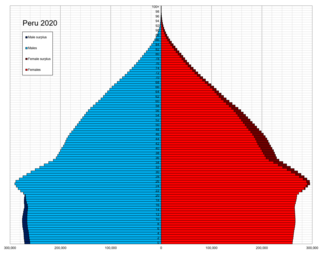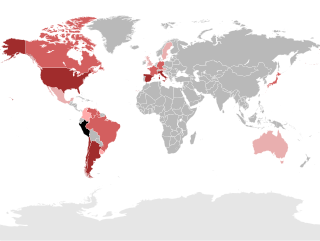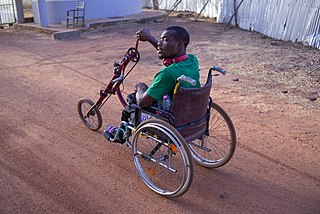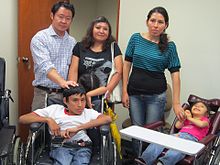
This is a demography of the population of Peru including population density, ethnicity, education level, the health of the populace, economic status, religious affiliations and other aspects of the population.

Disability is the experience of any condition that makes it more difficult for a person to do certain activities or have equitable access within a given society. Disabilities may be cognitive, developmental, intellectual, mental, physical, sensory, or a combination of multiple factors. Disabilities can be present from birth or can be acquired during a person's lifetime. Historically, disabilities have only been recognized based on a narrow set of criteria—however, disabilities are not binary and can be present in unique characteristics depending on the individual. A disability may be readily visible, or invisible in nature.
The disability rights movement is a global social movement that seeks to secure equal opportunities and equal rights for all people with disabilities.

Peruvians are the citizens of Peru. What is now Peru has been inhabited for several millennia by cultures such as the Caral before the Spanish conquest in the 16th century. Peruvian population decreased from an estimated 5–9 million in the 1520s to around 600,000 in 1620 mainly because of infectious diseases carried by the Spanish. Spaniards and Africans arrived in large numbers in 1532 under colonial rule, mixing widely with each other and with Native Peruvians. During the Republic, there has been a gradual immigration of European people. Chinese and Japanese arrived in large numbers at the end of the 19th century.

Inclusion, in relation to persons with disabilities, is defined as including individuals with disabilities in everyday activities and ensuring they have access to resources and opportunities in ways that are similar to their non-disabled peers. Disability rights advocates define true inclusion as results-oriented, rather than focused merely on encouragement. To this end, communities, businesses, and other groups and organizations are considered inclusive if people with disabilities do not face barriers to participation and have equal access to opportunities and resources.
Ableism is discrimination and social prejudice against people with physical or mental disabilities. Ableism characterizes people as they are defined by their disabilities and it also classifies disabled people as people who are inferior to non-disabled people. On this basis, people are assigned or denied certain perceived abilities, skills, or character orientations.
Peruvian Sign Language is a Peruvian language created and used by the Deaf community in Peru. It has been officially recognized by Peruvian law since 2010. It is not clear how many users there are in the country; the most recent general census registered little more than 10,000, but the more specific census on people with special needs found around half a million people with hearing disabilities.
Disability in China is common, and according to the United Nations, approximately 83 million people in China are estimated to have a disability.

Disability in Ghana has a massive amount of stigma; Disabled children and adults are often assumed to be possessed by evil nature spirits.
The overall prevalence of people with disabilities is 4.52% of the population, i.e., 63.28 million, according to the ICMR's publication from the NFHS-5 survey 2019-21. India is a party to the United Nations Convention on the Rights of Persons with Disabilities. Legislation that affects people with disabilities in India includes the Rights of Persons with Disabilities Act, 2016, the Mental Health Care Act, 2017, the National Trust Act, 1999, and the Rehabilitation Council of India Act, 1992. People with disabilities in India are faced with negative social attitudes in the wider population.
In Japan, a person with a disability is defined as: "a person whose daily life or life in society is substantially limited over the long term due to a physical disability or mental disability". Japan ratified the United Nations Convention on the Rights of Persons with Disabilities (CRPD) on 20 January 2014.
Reliable information about disability in North Korea, like other information about social conditions in the country, is difficult to find. As of 2016, North Korea is a signatory to the United Nations Convention on the Rights of Persons with Disabilities.

Disability in Yemen has been increasing over time, especially because of increased conflict in the area. Disabled people in Yemen face many challenges due to poverty, lack of accessible infrastructure, gender segregation and more. The government of Yemen has passed laws to help protect the rights of disabled people in their country, but not all laws are equally enforced.
Disability affects many people in Zimbabwe in both rural and urban areas. In spite of services provided by the government, philanthropists and welfare agencies, people with disabilities and their families often face several barriers. Philanthropist, Jairos Jiri, started services for people with disability in Zimbabwe in the 1940s. He is regarded as the father or founder of disability work in Zimbabwe.
People with disabilities in Sri Lanka typically face significant stigma and discrimination. The main causes for disability in Sri Lanka are poor hygiene, lack of medical care, the prevalence of 30 years of war, the aftereffects of the 2004 tsunami, and an increase in accidents.

Singapore does not have a formal definition of disability. Singapore signed on to the Convention on the Rights of Persons with Disabilities in 2013 and coordinates the Enabling Masterplan with both government and non governmental organisations.
The 2017 Peru Census was a detailed enumeration and twelfth national population census of Peru. It was conducted by the Instituto Nacional de Estadística e Informática on Sunday, October 22, 2017. Its full name in Spanish is XII Censo de Población, VII de Vivienda y III de Comunidades Indígenas. The previous census performed in Peru was the 2007 Census.

People with disability in Zambia face many unique challenges. The country has been passing laws and policies to help people with disabilities in Zambia, however, social stigma and other factors sometimes interfere in people being able to access services and assistance. In addition, the HIV epidemic in Zambia also has a significant impact on the lives of people with disabilities.

Approximately 12 million French citizens are affected by disability. The history of disability activism in France dates back to the French Revolution when the national obligation to help disabled citizens was recognized, but it was "unclear whether or not such assistance should be public or private." Disabled civilians began to form the first associations to demand equal rights and integration in the workforce after the First World War. Between 1940 and 1945, 45,000 people with intellectual disabilities died from neglect in French psychiatric asylums. After the Second World War, parents of disabled children and charities created specialized institutions for disabled children for whom school was not accessible. In 2018, the French Government began to roll out a disability policy which aimed to increase the allowance for disabled adults to €900 per month, improve the digital accessibility of public services, and develop easy-to-read and understand language among other goals.

There are around 447,600 people with disability in Cuba. A large number of people with disabilities in Cuba have an intellectual disability and about 3.2 percent have a severe disability. The government of Cuba has a medical model of disability in its approach to policies on people with disabilities. Another unique challenge that people with disabilities in the country face is due to the economic embargo of Cuba which has caused shortages in medical materials and assistive technology. The Constitution of Cuba has provisions for protecting the rights of people with disabilities and the country signed onto the Convention on the Rights of Persons with Disabilities in 2007.











